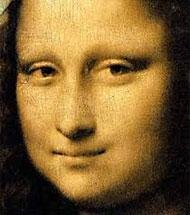Unknown Leonardo da Vinci
Unknown Leonardo da Vinci
Leonardo da Vinci
They called him “fat boy,” this seventeen-year old apprentice in the studio of Florentine painter Verrocchio who would receive care packages from his step-father, a pastry chef. The bastard son of a Florentine notary and a lady of Vinci, the boy’s doting step-father gave him a taste for marzipans and sugars from a very young age.
After three years as an apprentice, twenty-year old Leonardo took a job as a cook at the Tavern of the Three Snails near the Ponte Vecchio, working during the day on the few commissions his master sent his way and slinging polenta in the evenings. Polenta was the restaurant’s signature dish, a tasteless hash of meats and corn porridge. When in the spring of 1473, a poisoning sickened and killed the majority of the cooking staff of the tavern, Leonardo was put in charge of the kitchen. He changed the menu completely, serving up delicate portions of carved polenta arranged beautifully on the plate. However, like most tavern clientele, the patrons preferred their meals in huge messy portions. Upset with the change in management, they ran Leonardo out of a job.
He wrote a humble letter to Ludovico Sforza, the future Duke of Milan, by way of a job application: “My painting and my sculpture will stand comparison with that of any other artist. I am supreme at telling riddles and tying knots. And I make cakes that are without compare.”
Sforza took him on neither as a cook, painter, or sculptor, but instead as a lute player and after-dinner entertainer. Leonardo attempted to show his lord his new inventions for fortifications, catapults, and ladders, but Sforza paid little attention until the lute-player fashioned his inventions out of marzipan and jelly. Sforza charged the young man with refurbishing his kitchen, a task which would consume the life of Leonardo and the entire Sforza court.
Five hundred years before modern cooking books, The Kitchen Notebooks of Leonardo da Vinci envisioned a culinary world as studio and laboratory, where food was to be prepared efficiently, beautifully, and ingeniously. Unfortunately, Italian food of the late fifteenth century had less to do with the luxurious feats of Ancient Rome and more to do with the rustic tastes of the Goths, whose dishes included meats and birds for those who could afford it, and an endless parade of porridge and gruel for those who could not. Leonardo was horrified by much of the food that was served to him, both at court and at home, and he included in his notebooks a running list of dishes that he hated, but that his own servant insisted on serving him: jellied goat, hemp bread, inedible turnips, and eel balls—which he notes, “this dish if eaten often can cause madness.”
Leonardo believed that every kitchen task could be mechanized—crushing garlic, pulling spaghetti, plucking ducks—but the machines Leonardo imagined were sometimes far more elaborate than the task required. His invention for a giant whisk twice the size of a man involved an operator from within who was constantly in danger of being wisked into the sauce. (See below) Another model involved a team of three horses engaged in the task of crushing a nut. One machine was intended to be operated by bees.
Leonardo was also a master of dining etiquette. Bad behavior at table was common among the courtiers. So Leonardo had to remind them that a courtier:
* He should not place his head upon his plate to eat.
* Neither should he sit beneath the table for any length of time.
* He should not place unpleasing or half-chewed pieces of his own food upon his neighbor’s plate without first asking him.
* He should not wipe his knife upon his neighbor’s clothing.
* Nor use his knife to carve upon the table.
* He should not set loose birds upon the table.
* Not snakes nor beetles...
* And if he is to vomit then he leaves the table.
* Likewise if he is to urinate.
Leonardo’s notebooks also humorously reveal the hidden violence of the Sforza court. He included instructions for hiring a new taster after Sforza’s dies from a poisoning (“the old taster has done his job too well”). What Leonardo didn’t know at the time was that Sforza had his man killed in order to install an actual poisoner, hired to slowly kill his elder brother and assume the Dukedom. The possibility of an actual assassination was a real concern at the Sforza court, and Leonardo explained that there should be a refined protocol to the affair:
"If there is an assassination planned for the meal, then it is seemliest that the assassin should be seated next to he who is to become the subject of his craft...as this will cause less interruption to the conversation if the action of the event is confined to one small area...After the corpse (and bloodstains if any) are removed by the serving persons, it is customary for the assassin also to withdraw from the table as this presence may sometimes be disturbing to the digestions of the persons who now find themselves seated next to him, and to this end a good host will always have a fresh guest, who has waited without, ready to join the table at this juncture."

Congratulations @pacification! You have received a personal award!
Click on the badge to view your Board of Honor.
Do not miss the last post from @steemitboard:
SteemitBoard World Cup Contest - The results, the winners and the prizes
Congratulations @pacification! You received a personal award!
You can view your badges on your Steem Board and compare to others on the Steem Ranking
Vote for @Steemitboard as a witness to get one more award and increased upvotes!